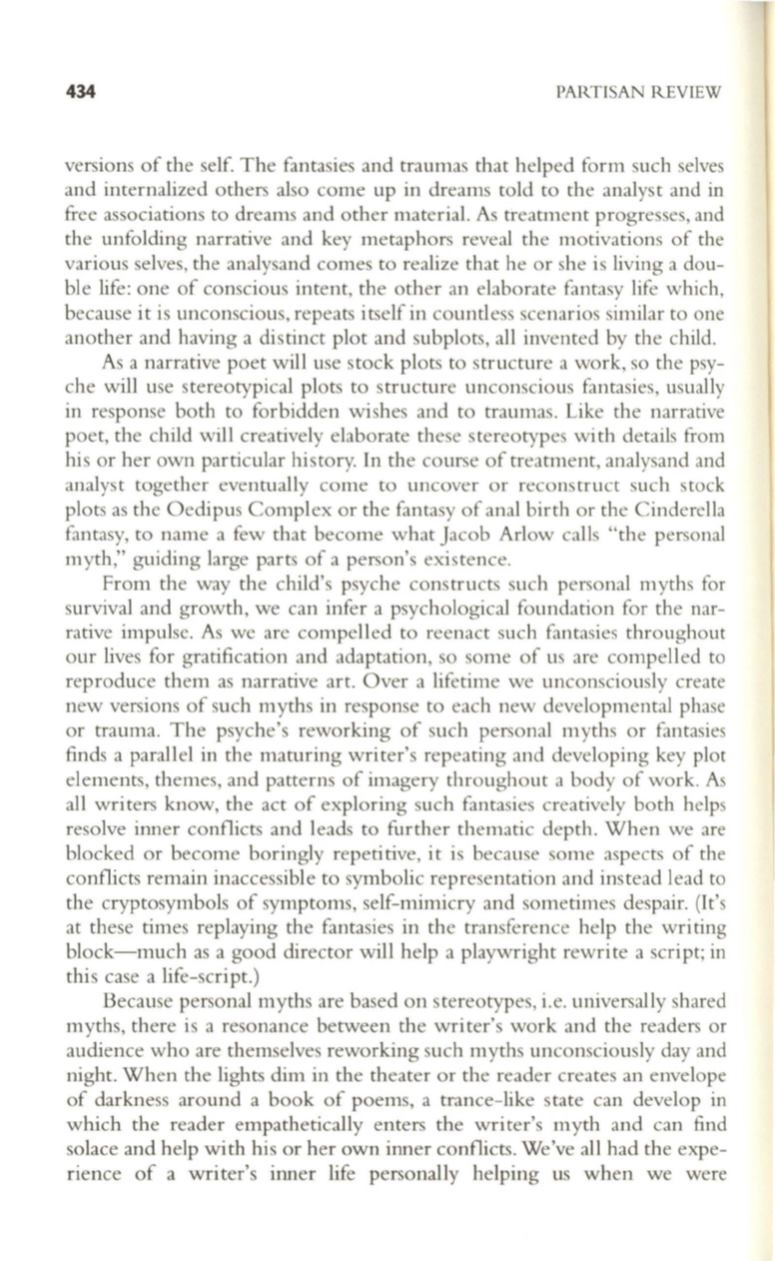
434
PARTISAN REVIEW
versions of the self. The fantasies and traumas that helped form such selves
and internalized others also come up in dreams told to the analyst and in
free associations to dreams and other material. As treatment progresses, and
the unfolding narrative and key metaphors reveal the motivations of the
various selves, the analysand comes to realize that he or she is living a dou–
ble life: one of conscious intent, the other an elaborate fantasy life which,
because it is unconscious, repeats itself in countless scenarios similar to one
another and having a distinct plot and subplots, all invented by the child.
As a narrative poet will use stock plots to structure a work, so the psy–
che will use stereotypical plots to structure unconscious fantasies, usually
in response both to forbidden wishes and to traumas. Like the narrative
poet, the child will creatively elaborate these stereotypes with details from
his or her own particular history. In the course of treatment, analysand and
analyst together eventually come to uncover or reconstruct such stock
plots as the Oedipus Complex or the fantasy of anal birth or the Cinderella
fantasy, to name a few that become what Jacob Arlow calls "the personal
myth," guiding large parts of a person's existence.
From the way the child's psyche constructs such personal myths for
survival and growth, we can infer a psychological foundation for the nar–
rative impulse. As we arc compelled to reenact such fantasies throughout
our lives for gratification and adaptation, so some of us are compelled to
reproduce them as narrative art. Over a lifetime we unconsciously create
new versions of such myths in response to each new developmental phase
or trauma. The psyche's reworking of such personal myths or fantasies
finds a parallel in the maturing writer's repeating and developing key plot
elements, themes, and patterns of imagery throughout a body of work. As
all writers know, the act of exploring such fantasies creatively both helps
resolve inner conflicts and leads to further thematic depth. When we are
blocked or become boringly repetitive, it is because some aspects of the
conflicts remain inaccessible to symbolic representation and instead lead to
the cryptosymbols of symptoms, self-mimicry and sometimes despair. (It's
at these times replaying the fantasies in the transference help the writing
block-much as a good director will help a playwright rewrite a script; in
this case a life-script.)
Because personal myths are based on stereotypes, i.e. universally shared
myths, there is a resonance between the writer's work and the readers or
audience who are themselves reworking such myths unconsciously day and
night. When the lights dim in the theater or the reader creates an envelope
of darkness around a book of poems, a trance-bke state can develop in
which the reader empathetically enters the writer's myth and can find
solace and help with his or her own inner conflicts. We've all had the expe–
rience of a writer's inner life personally helping us when we were


